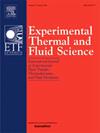Heat transport during drop impact onto a heated wall covered with an electrospun nanofiber mat: The influence of wall superheat, impact velocity, and mat thickness
Abstract
Nanofiber surface coating is a promising method for the enhancement of heat transfer during spray cooling. In the present work, the drop dynamics as well as local and overall heat transfer during single drop impact onto a heated wall covered with a polyacrylonitrile (PAN) nanofiber mat are investigated to obtain insight into the mechanisms governing the heat transport enhancement. The influence of wall superheat, drop impact velocity, and mat thickness on the hydrodynamics and heat transfer from the heated wall to the fluid is studied. The experiments were conducted inside a temperature-controlled test cell with a pure vapor atmosphere maintained with refrigerant FC (perfluorohexane). The temperature field at the solid–fluid interface was observed with a high-speed infrared camera, and the heat flux field was derived by solving a three-dimensional transient heat conduction equation within the substrate. The presence of the nanofiber mat on the heater surface suppresses the drop receding phase due to the pinning of the contact line at the end of the spreading phase. Two different heat transfer scenarios are observed depending on the wall superheat and drop impact velocity: scenario (I), in which the liquid drop completely penetrated through the porous nanofiber mat and made contact with the heater surface; and scenario (II) in which the vapor produced inside the pores of the nanofiber mat prevented the liquid drop from touching the heater surface. In scenario (I), an up 450% heat flow enhancement during the sessile drop evaporation stage has been observed. In scenario (II), a 80% heat flow enhancement at this stage has been registered.

 求助内容:
求助内容: 应助结果提醒方式:
应助结果提醒方式:


